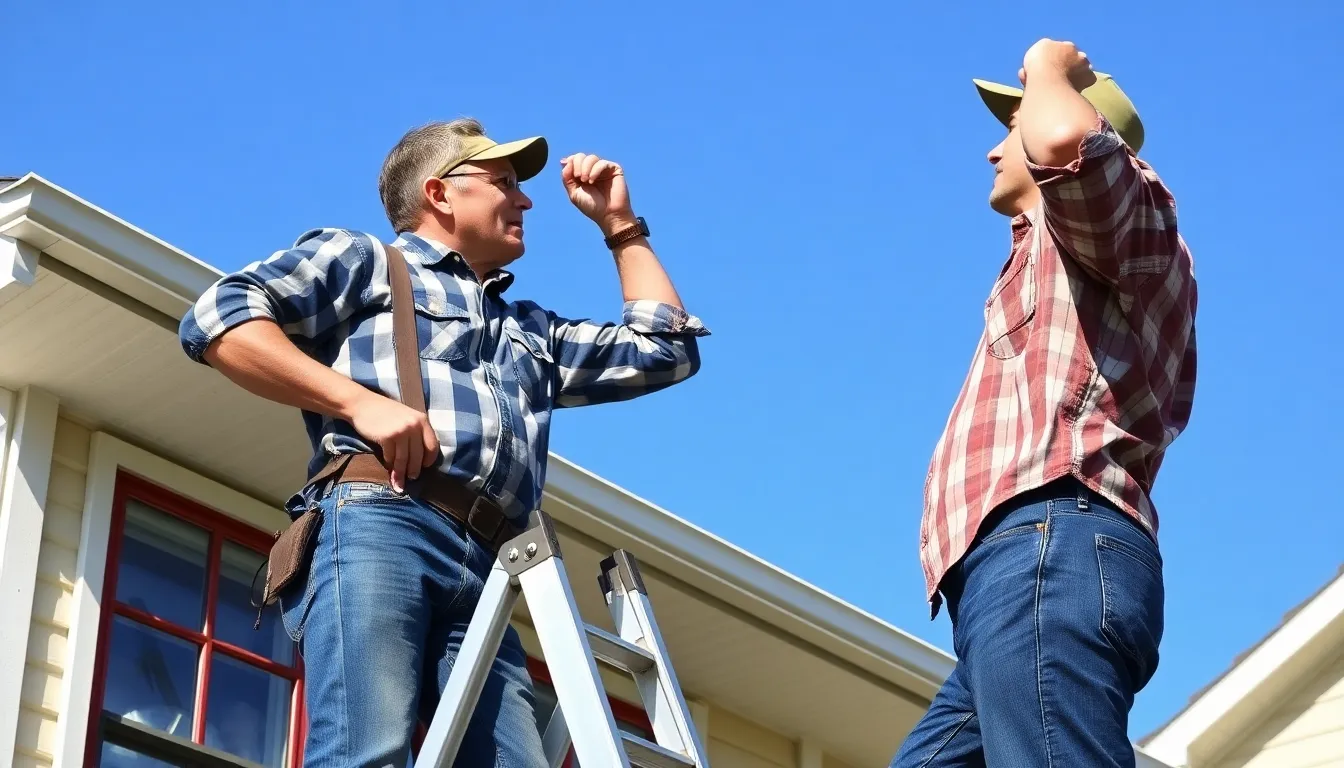Home exterior maintenance might not sound like the most thrilling topic, but it’s the unsung hero of homeownership. Think of it as the superhero cape that keeps your house looking sharp and standing strong against the elements. A little TLC can save homeowners from costly repairs and keep their curb appeal soaring higher than a kite on a windy day.
Table of Contents
ToggleImportance of Home Exterior Maintenance
Home exterior maintenance plays a vital role in protecting a property from weather damage and deterioration. Regular upkeep prevents small issues, like cracks in siding or damaged roofs, from escalating into costly repairs. Curb appeal boosts not only aesthetics but also property value, making maintained homes more attractive to potential buyers.
Neglecting exterior maintenance can lead to problems such as mold growth, wood rot, and pest infestations. Each of these issues not only affects safety but can also incur significant repair costs over time. Routine inspections help identify concerns early, allowing homeowners to address them before they worsen.
Investing in maintenance tasks, like gutter cleaning and power washing, contributes to the longevity of a home’s exterior. Such actions enhance the overall appearance and can extend the life of roofing materials and siding. Painting and sealing also protect surfaces from harsh elements, increasing durability and reducing the frequency of repairs.
Additionally, maintaining outdoor fixtures such as railings and walkways ensures safety for residents and visitors. Using quality materials during maintenance activities leads to better results and extends the lifespan of exterior components. A well-maintained exterior not only reduces the risk of accidents but also fosters a sense of pride for homeowners.
Financially, proactive maintenance activities can save households thousands of dollars in the long run. By prioritizing these tasks, homeowners can ensure a safe, appealing, and efficient living environment.
Essential Maintenance Tasks

Home exterior maintenance involves several essential tasks that contribute to the property’s longevity and aesthetic appeal. Regular attention to these areas ensures a safe and beautiful environment.
Cleaning Gutters and Downspouts
Cleaning gutters and downspouts prevents water damage. Clogged gutters can lead to overflow, damaging roofs and siding. Homeowners should aim to clean them at least twice a year, typically in spring and fall. Using a sturdy ladder for access is crucial. After clearing debris, checking downspouts for blockages ensures proper drainage. A functioning gutter system directs water away from the foundation, preventing costly repairs.
Inspecting and Repairing Siding
Inspecting and repairing siding protects against moisture intrusion. Homeowners should examine siding for cracks, warping, or signs of rot every six months. Minor issues can often be fixed with sealants or caulking. Replacement may be necessary for severely damaged areas. Maintaining siding not only enhances curb appeal but also fortifies the home against the elements. Quality exterior paint can extend the life of siding, so consider repainting every five to seven years.
Maintaining Windows and Doors
Maintaining windows and doors boosts energy efficiency. Regular inspection for gaps and leaks can prevent air loss. Weatherstripping should be replaced if it shows wear. Cleaning window frames and tracks enhances function and appearance. Homeowners must look for signs of rot or mold around frames, addressing these issues promptly. Ensuring locks function properly enhances security while maintaining the overall integrity of the home’s exterior.
Seasonal Maintenance Checklist
A seasonal maintenance checklist ensures a home remains in optimal condition throughout the year. Regular tasks help identify issues early and maintain the home’s appearance and integrity.
Spring Maintenance Tips
Inspect the roof for missing or damaged shingles after winter storms. Clean the gutters and downspouts to prevent water accumulation, which can lead to structural damage. Fertilize the lawn and reseed any bare patches to promote healthy growth. Trim shrubs and trees as needed to maintain shapes and prevent overgrowth from affecting the siding or roof. Check exterior paint for peeling or cracking, addressing any areas promptly.
Summer Maintenance Tips
Harness the summer sun to clean outdoor decks and patios with a power washer. Inspect windows and doors for proper seals, replacing weather stripping where necessary. Mow the lawn regularly, maintaining a height of 2.5 to 3.5 inches for optimal health. Ensure that outdoor lighting fixtures are working correctly, replacing bulbs as needed. Schedule pest control measures to prevent infestations during warmer months.
Fall Maintenance Tips
Prepare the home for winter by cleaning gutters once more, ensuring they’re free of debris to manage fall leaves. Inspect the chimney for creosote buildup before the heating season begins. Replace any damaged window screens to keep out insects as temperatures drop. Check and clean outdoor furniture, storing it safely for the colder months ahead. Service the HVAC system to ensure efficiency and comfort during winter months.
Winter Maintenance Tips
Shovel snow from walkways and driveways to prevent ice formation and ensure safety. Inspect insulation in the attic and around pipes to prevent heat loss and freezing. Monitor external faucets for leaks and insulate any exposed pipes. Check for drafts around windows, which may indicate the need for caulking. Keep the home well-ventilated to reduce moisture buildup and prevent mold growth during the cooler months.
DIY vs. Professional Services
Homeowners often weigh the benefits of DIY maintenance against hiring professionals. Tackling tasks like gutter cleaning, painting, and pressure washing can empower them to save money and personalize their homes. Many homeowners find satisfaction in completing projects themselves, fostering a deeper connection to their living spaces.
In contrast, professionals bring expertise and efficiency. Skilled technicians possess knowledge that many homeowners lack, ensuring tasks are completed correctly the first time. They can identify underlying issues, like structural damage or pest infestations, that might not be obvious to the untrained eye. When it comes to safety-critical tasks, hiring a professional often mitigates risks.
Cost is a major deciding factor. DIY projects may seem more budget-friendly initially, but mistakes can lead to expensive repairs. Professionals may charge higher upfront fees, but their work typically comes with warranties, offering peace of mind.
Time constraints also influence choices. Busy homeowners might find it challenging to allocate time for extensive maintenance. Professionals can work on projects while homeowners focus on other priorities, completing tasks more quickly and efficiently.
Consider the scope of work when making a decision. For extensive projects such as roof repairs or significant exterior renovations, hiring professionals can ensure compliance with local regulations and proper installation. Smaller tasks, like seasonal inspections or routine gutter cleaning, often suit DIY efforts.
Ultimately, the best choice hinges on individual skills, available time, and the specific maintenance task at hand. Balancing DIY efforts with professional services can help maintain a home’s exterior while managing costs effectively.
Regular home exterior maintenance is essential for preserving a property’s value and aesthetic appeal. By staying proactive with tasks like gutter cleaning and siding inspections, homeowners can prevent costly repairs and enhance their living environment. Investing time and resources into maintenance not only protects against weather-related damage but also fosters a sense of pride in homeownership.
Balancing DIY efforts with professional services can lead to effective maintenance strategies tailored to individual needs. Ultimately, prioritizing exterior upkeep ensures a safe and beautiful home for years to come. Embracing these practices will result in a resilient property that stands the test of time.



